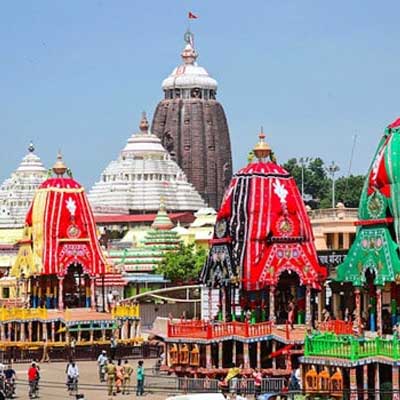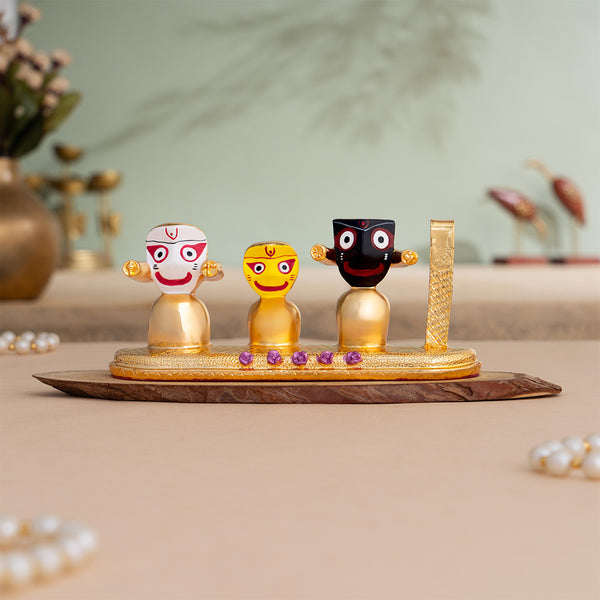The Jagannath Temple, located in the seaside city of Puri in the eastern Indian state of Odisha, is a well-known Hindu pilgrimage site and one of the most prominent temples in the country.
The temple is dedicated to Lord Jagannath, a form of Lord Vishnu, and has religious and cultural significance for worshippers.
The Jagannath Temple, which dates back to ancient times, is an architectural masterpiece recognised for its spectacular and ornate Kalinga style of architecture.
The temple complex is fortified with high walls and contains a number of shrines, rooms, and courtyards.
The temple's principal deity is Lord Jagannath, accompanied by his siblings, Lord Balabhadra and Devi Subhadra.
These deities' idols are wonderfully crafted and constructed from a specific sort of wood, and they are ceremonially replaced every 12 or 19 years in a magnificent celebration known as the Nabakalebara.

Lord Jagannath Murti - Gold Plated (2.75 Inch)
Interesting Facts about Jagannath Temple
1. Colossal Chakra Mystery

The Sudarshan Chakra atop the temple is the focus of not one but two unsolved mysteries.
The Sudarshan Chakra is a massive metal structure that weighs tons, and it is still puzzling to consider how such a massive structure made it to the temple's pinnacle.
The architecture of this building is the second mystery, as it appears the same from every angle. The Chakra reportedly looks the same way when viewed from every direction throughout the city.
This is a puzzle in architectural design that has baffled experts for quite some time.
2. Jagannath Flag

Some things never fail to remind us how marvelous our planet is. One of those remains to be the mysteries that surround things that, even years later, we're discussing.
When the wind blows in one direction, the flag atop the Jagannath Temple flutters in the opposite direction.
To this day, no scientific explanation has been found for this bizarre occurrence. Trained priests climb the temple's structure daily to hand replace the 20-foot-wide triangular flag. This is a difficult task to do.
For the past 1800 years, it has been customary for a saint to climb the temple's 45-story dome and replace the banner there. The temple shall be shut down for 18 years if this routine is broken for even a day.
3. Wisdom Idols

Wooden idols are set ablaze during Nabakalebara and replaced with new ones. Every 8, 12, or 19 years, this ceremony is undertaken.
Carefully chosen sacred neem trees that meet strict specifications are selected for this specific purpose.
The carving is completed in secrecy by handpicked carpenters in about 21 days. Near the Koili Vaikuntha, the ancient idols have been laid to rest. Millions of believers attended the final Nabakalebara in 2015.
4. Temple was Plundered 18 times

The Temple is home to priceless treasures that date back centuries, including gold and precious stones. Because of this, it was vulnerable to as many as 18 different invasions in the past.
The temple was not accessible to the public at any point during Aurangzeb's rule and did not reopen until after he had passed away.
5. Temple was Built in the 12th Century

The Jagannath Temple, an ancient Hindu pilgrimage site in Puri, Odisha, has a rich history that dates back to the 12th Century CE.
It was commissioned by King Anantavarman Chodaganga of the Ganga dynasty, who envisioned a magnificent temple dedicated to Lord Jagannath.
Over the centuries, subsequent monarchs from both the Ganga dynasty and the Gajapati family played pivotal roles in expanding and renovating the temple complex.
The successive rulers recognized the temple's cultural and religious significance, and their contributions ensured its preservation and enhancement.
Their devotion and patronage further strengthened the temple's position as a prominent spiritual and cultural hub, attracting devotees and pilgrims from far and wide.
Today, the Jagannath Temple stands as a testament to the remarkable craftsmanship and devotion of the past rulers, leaving an indelible mark on the landscape of Indian temple architecture and serving as a sacred place of worship for millions of devotees.
6. Temple doesn't have Shadow

The Jagannath Temple is a testament to the engineering skill of our ancestors. In no way, shape, or form does this temple cast a shadow. Can you imagine that?
The shadows that are with us all day, every day, suddenly retreating, failing to align with the natural laws of the world by not appearing in the Jagannath Temple.
The temple never casts a shadow, no matter the time of day or where the sun is in the sky. There is no metaphor there. The truth is that no shadow exists.
7. Waves sound

It's been said, and it's been observed by many, that you can hear the waves crashing on the shore just outside the Jagannath Puri temple, even when you're inside.
However, once you've passed a certain point, you won't be able to hear that sound again on your way back to where you first left the temple.
Visits to the Singha Dwara gateway reportedly muffle the sound of the ocean, which is particularly noticeable after dark.
The legend relates that Subhadra Mayi, the sister of two lords, asked for peace and quiet inside the temple, and she was given her request. When you leave the temple, the sea's roar returns.
8. Various Small Temples are Present

The temple complex is home to more than thirty more, smaller temples.
The Vimala Temple and the Narasimha Temple are both older than the Jagannath Temple in and of itself!
In addition to the temples, this complex is home to five sacred fish tanks: Indradyumna, Rohini, Narendra, and Markandya. Swetaganga is the fifth and final tank.
9. Mahaprasad is Never Wasted

Not only is it morally wrong to throw away edible food, but doing so is also looked down upon in Hindu mythology.
Approximately between 2,000 and 200,000 people, respectively, visit the temple every day.
Because every last morsel of the prepared Prasad is consumed, locals here refer to it as the efficient administration of God's will.
Another peculiar aspect of this method is that the pots are stacked atop one another; for some reason, the one on top always gets cooked first.
10. Rath Yatra

The legend speaks about the three goddesses loading up their elaborately decorated chariots once a year for the Rath Yatra festival and riding them through the streets of Puri to pay a visit to their maternal aunt at the Gundicha shrine.
After seven days, they make their way back to the temple. Thousands upon thousands of worshippers go from all over the world to see the God who, once a year, emerges from his temple to personally bless his followers.

Lord Jagannath, Subhadra, Balabhadra Murti Set - Gold Plated (4 Inch)

Lord Jagannath Puri 3D Wall Frame - Gold Plated Finish
Conclusion
Nestled in the enchanting city of Puri, Odisha, the Jagannath Temple stands tall as a captivating symbol of the region's profound cultural and religious heritage.
With its magnificent architecture and deep-rooted historical significance, this temple embodies the devotion and vibrant traditions that have shaped Odisha over the ages.
Beyond its architectural splendor, the Jagannath Temple serves as a living testament to the customs and rituals that have been faithfully practiced for centuries.
The vibrant Rath Yatra, with its exuberant processions and joyous celebrations, is an annual spectacle that attracts millions of devotees from all corners of the globe.
FAQs
1) How to buy original Jagannath idol online?
-
To buy an original Jagannath idol online, choose trusted spiritual stores like Svastika.in that offer traditional designs, handcrafted details, and authentic quality rooted in Puri’s temple culture.
2) What is the mystery behind the Jagannath Temple kitchen?
-
The temple kitchen is said to cook food for thousands daily without any wastage. No matter how many people come, the prasad is always just enough, which is considered a divine miracle.
3) Why is no bird seen flying above the Jagannath Temple?
-
It’s a well-known mystery that no bird flies over the temple dome. Many believe it’s due to divine energy or blessings that keep the area untouched and spiritually protected.
4) How is Ratha Yatra connected to the Jagannath Temple?
-
Ratha Yatra is the temple’s most famous festival, where Lord Jagannath and his siblings ride chariots through Puri. It’s a symbolic journey of the deities coming out to bless all devotees.





